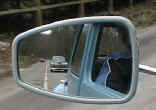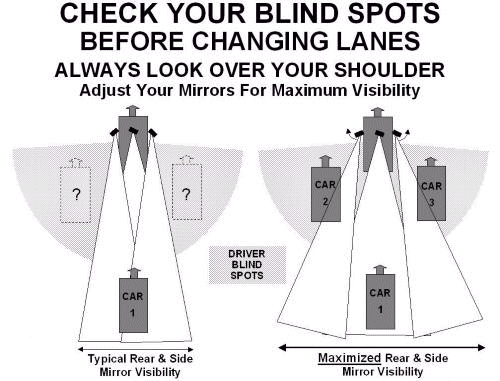Car Mirror Safety  George Platzer, a member of the Society of Automotive Engineers and a consultant who holds several patents on mirror design, has developed a simple rearview mirror-adjustment system that eliminates blind spots and gives drivers 20-20 hindsight. Rotate your mirrors about seven degrees outward to cover the field of view normally missed, i.e., your blind spot. "Most people's side mirrors are aimed back along the flanks of their cars," Platzer says, "but much of the area seen in the outside mirror is already covered by your inside rearview mirror. You might as well point those side mirrors out where they can do some good." Platzer's process:
Here's how the system works in traffic. The inside mirror is your primary mirror. It shows you everything except the blind zone. The outside mirrors show you only the blind zones. When changing lanes, first look in the inside mirror to observe traffic to the rear. Then look in the outside mirror to see if there's a car in the blind zone. A car passing from behind will first appear in your center rearview mirror. Before it leaves that mirror, it will appear in the side mirror, and as it passes from the side mirror's view, it will appear in your peripheral vision. The only downside to Platzer's method is a loss of visual reference to your own vehicle: the fender edge you were used to seeing is now gone. But you'll soon adapt to the new position, as traffic behind you flows from your center mirror to your side mirrors (or vice versa if you're doing the passing). The end result of Platzer's mirror-adjustment method is almost unbroken visibility behind and to the sides of your car. Continually scanning what's ahead and behind will keep you visually and mentally on top of the situation.  |